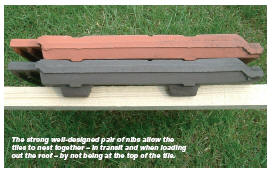 |
 |
 |
 |
 |
 |
 |
|
Check out our web directory of the UK
roofing and cladding industry
www.roofinfo.co.uk |
Sign up for our monthly news letter. |
|
|
|

Like most things in roofing, we take nibs
for granted when they are a very important feature of a good tile.
Nibs are the projection on the underside of a tile
close to the head, used to hook the tiles onto a batten or similar
horizontal ledge. They can be one small nib on its own, two or three
separate nibs, or one continuous nib across the head of the tile. Some
are at the head of the tile while others are a short distance down the
underside. Some are pressed while others are moulded. In most cases the
nib is directly above the nail hole, but there are exceptions to every
rule.
Each design and location has its advantages and disadvantages which I
will try to explain.
Types
Tiles with one nib are more difficult to locate and keep straight as
they can swing about the nib, especially if the nib is not central. Some
clay single pantiles have their nibs below the pan of the corrugation
making them offcentre, and the tile tends to swing clockwise through
about 20° when severe winds lift them off the tile below. A similar
effect can be seen when one of a pair breaks off, or is cut off, such as
down the side of a hip.
Tiles with two or three nibs are much easier to
locate and keep straight as the nibs are normally located as far apart
as is possible without weakening the tile. Nibs that are located close
to the centre of the tile are stronger than those located at the far
corners.
Tiles with a continuous top nib can be difficult
to locate if the batten is uneven, such as at a batten joint. In some
instances the nib is very shallow – to save weight, material and make
the tile easy to stack. This can make the tile difficult to stack out on
the roof and they can vibrate off the batten more easily than with a
larger nib.
Nibs that are located at the top edge of the tile
are more vulnerable to being broken off than those located a short
distance down the underside of the tile, but are better for weather
resistance as the nail hole is closer to the top edge. Tiles with the
nib a short distance down the underside of the tile have poorer weather
resistance because the nail hole is closer to the bottom of the
head-lap, and often cannot be nailed as the nail-hole falls below the
headlap. Also with i n t e rlocking tiles the further the nib is away
from the head of the tile the longer the unsupported section of nail
between the tile clip and the batten, making it less efficient. This can
be overcome with special tile clips, but they are more difficult to fit
as often it is almost impossible to see the batten that you are fixing
too.
Tiles with moulded nibs are stronger than nibs that are
pressed through the material and are in effect hollow. Pressing the nibs
leaves a recess into which nibs of another tile rest when stacked during
manufacture and transportation to site. However, some clay tiles are
very brittle, and the nibs can break off easily due to the sharp angles
of the nib-shape.
Hanging length
The hanging length of any tile is the distance from the face of the
nib to the bottom of the underside of the tile. This is important –
unless this distance is constant the leading edge of the tiles will not
line through and therefore the head-lap distance will vary.
While some handmade clay tiles look oldy-woldy, if the
leading edge does not form a straight line, there is more variation and
a |
 |
greater need to close down the gauge to
ensure that the minimum head-lap is achieved for all tiles. Most
machine-made tiles are made by extruding a continuous ribbon of clay or
concrete, which is then cut into one-tile lengths. With interlocking
tiles the nibs are moulded in the pallet that provides the shape of the
tile underside. If the knife that cuts the ribbon of material is
slightly out of position the hanging length will be different.
Like all manufactured products the hanging length must
be within a tolerance to achieve the required head-lap for weather
resistance.Nib angle
All tiles lay at an angle that is shallower than the rafter pitch as
the bottom of each tile rests on the head of the tile below. This means
that the face of the nib that rests on the top face of the batten is not
at right angles to the tile, but a few degrees greater.
With most plain tiles the difference between the rafter
pitch and the true tile pitch can be between 9° and 10°. But if the tile
has an excessive camber in its length, and/or width, this figure can
increase the angle of the nib face. With interlocking tiles the
difference is between 3° and 6°, depending upon the design and thickness
of the tile.
Fixings
Some clay pantiles do not have a nail hole fixing through the face
of the tile. Instead they have one through the top face of the nib.
This method of fixing is very good for preventing the
tile from slipping off the batten, but it is very difficult to drive the
nail home onto the nib, due to the lack of space, especially if the nib
is recessed, so it is not ideal for resisting wind uplift. Positioning
the nail hole in the nib does remove the nail hole from the face of the
tile, making better use of the head-lap to resist wind driven rain. As
the nail hole is located in the depth of the nib it weakens the nib and
if the nail is a tight fit and expands due to rust it can break the nib
off.
Stacking
Nibs that hang down below the tile can be a problem when
manufacturing and stacking the tiles. Some plain tiles have to be
stacked with alternate nibs at opposite ends to keep the stack from
breaking in transit. Other tiles, like concrete double roman tiles, have
a nib that coincides with the pan of the corrugation so they can all
stack the same way around.
Having tiles that are stacked the same way around
is easier and quicker to produce. Once on the roof stacking out the roof
requires tiles to be placed ready to fix. Often this requires one or
more tiles to be hooked onto the head of the tile below. Some tile
designs will allow this to be done while others will not, such as those
with a scoop.
The importance of nibs should not be
underestimated. They control the position of the nail hole and ensure
that the leading edge of the tiles all line up. We have to take out hats
off to the person who invented the tile nib as it makes roof tiling a
lot easier. |
| Compiled
by Chris Thomas, The Tiled Roofing Consultancy, 2 Ridlands Grove,
Limpsfield Chart, Oxted, Surrey, RH8 0ST, tel 01883 724774 |
|